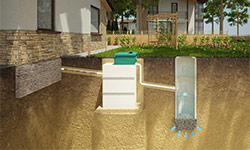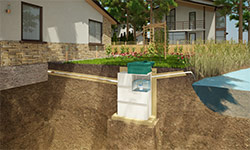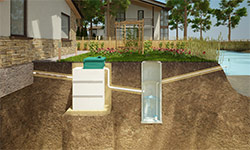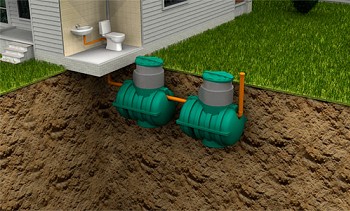How to choose an autonomous sewer for a private house - detailed instructions
Today we will find out how to choose an autonomous sewer in a private house and what is the best way to dispose of the liquid waste generated during the life of its inhabitants. The correct choice of a waste disposal system is possible only on the basis of an analysis of the advantages and disadvantages of each of the systems. In the article we will consider each design, the list of constituent elements, the principle of action, features, strengths and weaknesses, and also we will analyze in which case it is advisable to use one or another system.
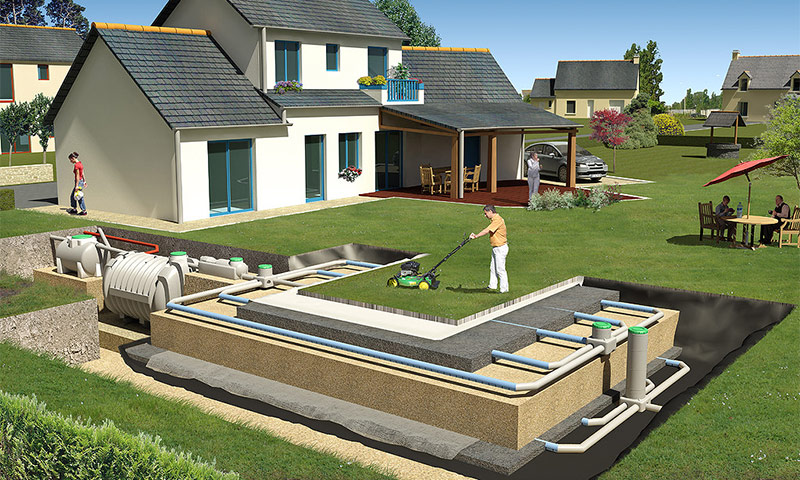
Content:
Cesspool
At one time, this type of autonomous sewage was the only one and had no alternative.
Device. The cesspools have a simple design and represent a sealed container dug up in the section into which sewage is drained along the collector. The pipeline is laid below the level of soil freezing, if for some reason this cannot be done, it is insulated.
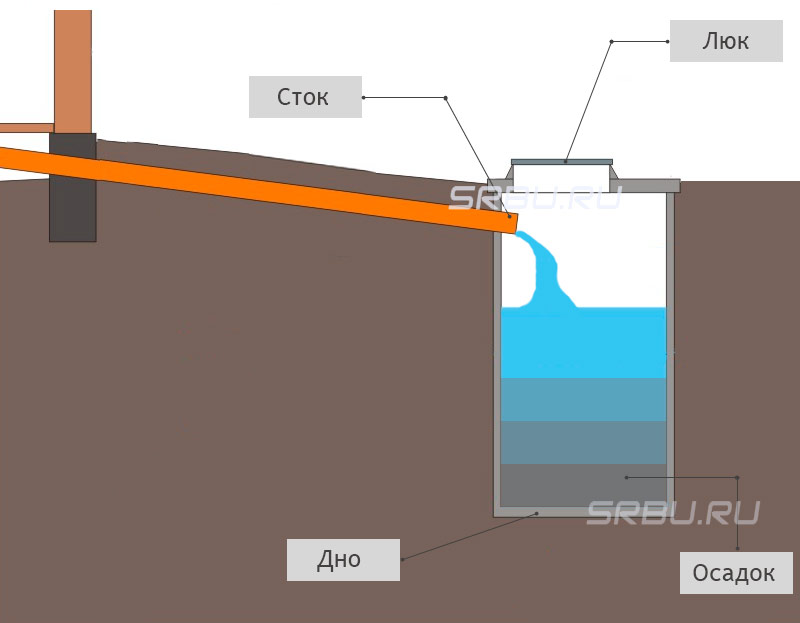
Drives used in private households are mainly made from the following materials:
- brick;
- reinforced concrete rings;
- plastic container;
- monolithic reinforced concrete structure.
Each of the aforementioned designs of cesspools has its own characteristics, which must be taken into account during their construction.
The drive is made of bricks. When constructing a drive from brick, it is allowed to use only ceramic, which is sufficiently resistant to aggressive environmental influences. The optimal shape of such a structure is round, viewed from above, which provides maximum strength.
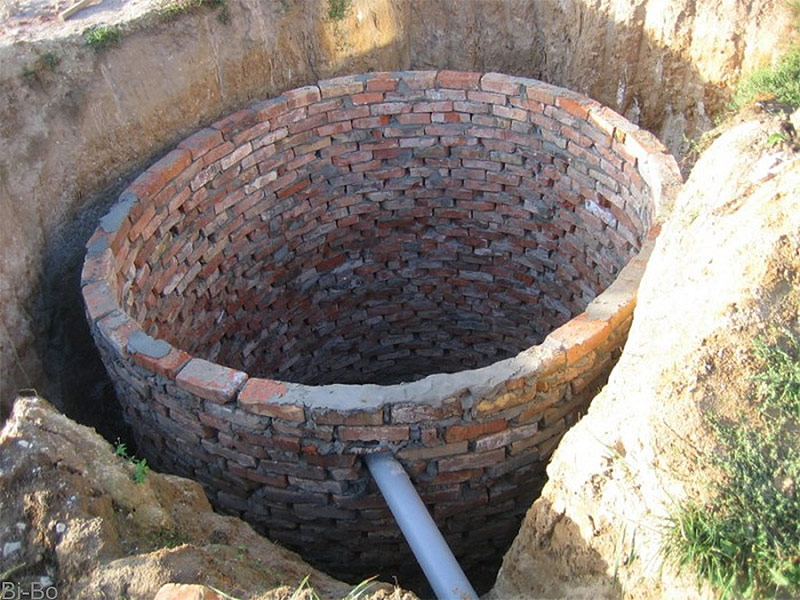
Reinforced concrete rings. They are mounted using heavy construction equipment. The use of well rings significantly increases the strength of the structure and eliminates the possibility of wall collapse during prolonged exposure to aggressive wastewater.
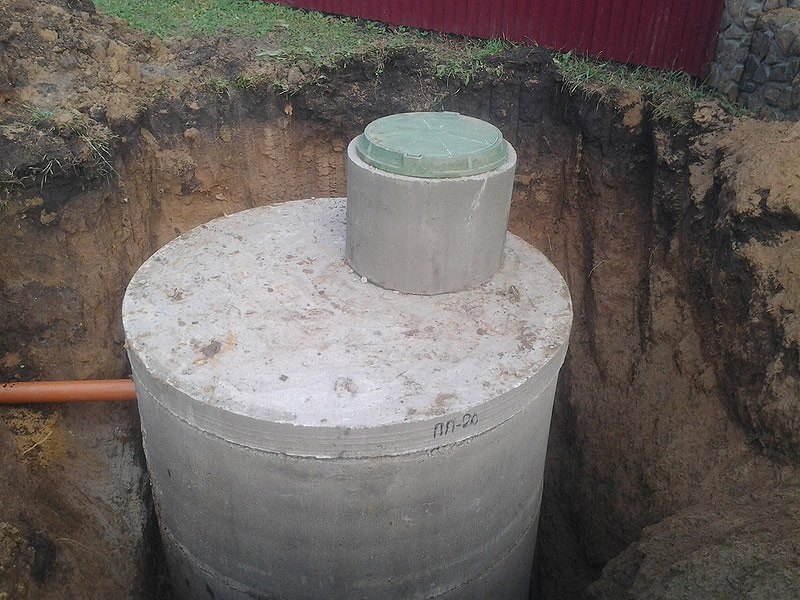
Storage tank made of plastic. It has fairly thick walls and is made of plastic that is resistant to moisture, acids and alkalis. Such a product is characterized by exceptional reliability and durability. The relatively small weight of the drive allows manual installation with the help of several assistants. But in this case you have to spend money on the purchase of the tank itself. There are many manufacturers and modifications of various capacities produced by them on the market.
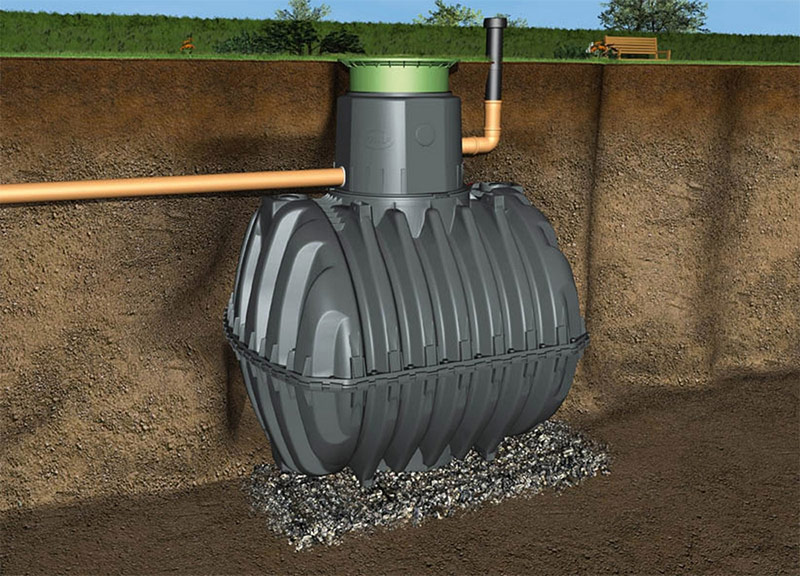
Monolithic reinforced concrete cesspool. It is cast directly on site in a removable formwork using high-quality cement-sand mix and steel reinforcement. Waterproofing is applied to the outer surface of the walls of the cesspool to protect the concrete from destruction under the influence of the external environment.
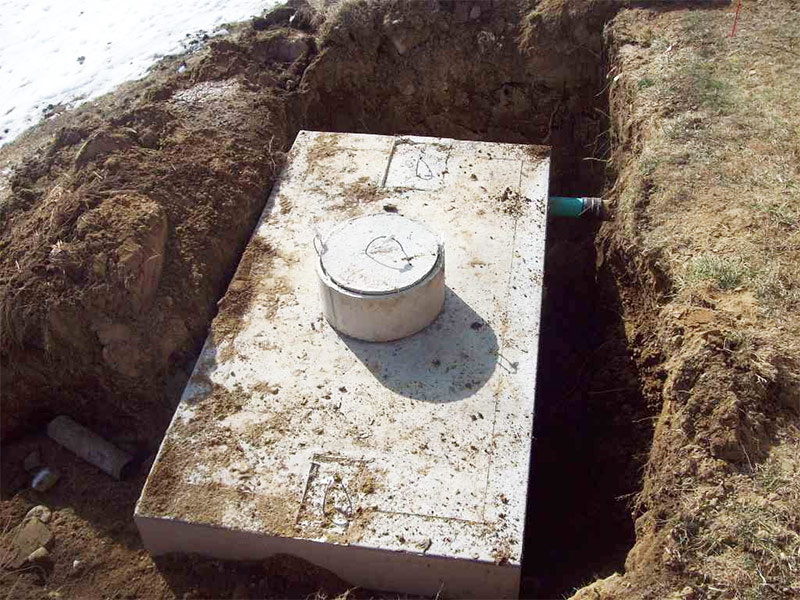
Accumulators of domestic wastewater are placed taking into account the requirements of SNiP 30-02-97 and SanPiN 42-128 -4690-88:
- The distance to the water pipelines is not less than 10 m, to the wells - not closer than 20 m, to the borders of the site - more than 1 meter.
- The maximum depth of the cesspool is 3 m and will be determined taking into account the level of groundwater.
- The distance to residential buildings and farm buildings should be at least 10-12 meters. Close proximity can lead to undermining of foundations.
Principle of operation. All sewage drains through the pipes enter the tank. As the stocks accumulate, they are pumped out by specialized sewage vehicles. The level of liquid waste in the cesspool should not exceed the level of 0.35 m above ground level. Overfilling can lead to runoff on the ground and contamination of the soil and aquifers.The cesspool is cleaned as necessary, but at least once every six months. Disinfection of drives using special solutions is performed with the same frequency.

+ The advantages of cesspools
- The complete tightness of a serviceable drive prevents the possibility of contamination of soil and aquifers.
- The simplicity and reliability of the structure, which can be built on its own without the involvement of specialists.
- The relatively low cost of acquiring and installing a finished drive made of plastic.
- Completely non-volatile system.

- Cons of cesspools
- The need for periodic cleaning of drives from liquid waste. Such structures will be optimal only in houses intended for temporary residence of a small number of people.
- With a volume of effluent more than 1 cubic meter. meters per day, even large drives of 6 cubic meters. meters are filled up within a week, and their operation is too expensive.
- Very unpleasant odor during cleaning operations.
- When arranging a cesspool on a site, it is necessary to take into account not only sanitary standards, but also the possibility of accessing a car for pumping waste water.
- Cannot be equipped with a high level of groundwater.
In which case is it worth using a cesspool. An accumulative cesspool is used mainly in private houses in summer cottages not intended for permanent residence. This is due to limited capacity, which necessitates frequent cleaning using sewage trucks. The cost of work with frequent cleaning can be a significant part of the cost of utilities. It should be borne in mind that with a high occurrence of groundwater it is necessary to use a plastic container. When using other types, it is difficult to achieve complete tightness. which will lead to the filling of the pit with groundwater.
Septic tanks
The basis of liquid waste is ordinary water, and the task of autonomous sewage is to ensure that it is treated to a safe level. Then there will be no need to collect and store a large number of effluents. This problem is solved with the help of septic tanks, which separate mechanical, biological and chemical pollution from water. The separation of water from solid insoluble impurities occurs by the flow of effluents from one tank to another. At the same time, the water is not completely purified and its post-treatment is required, which is carried out using various filtration systems. Let us consider in more detail the features of the device and the operation of septic tanks with various filtration systems. This will allow you to make the choice of the most suitable device for specific conditions, taking into account all factors.
Septic tank with filtration well
The device of a septic tank with a filtration well. Sewage treatment plants of this type can be built independently from available materials, or you can purchase ready-made, technically equipped devices for these purposes.
A septic tank with a filtration well consists of the following elements:
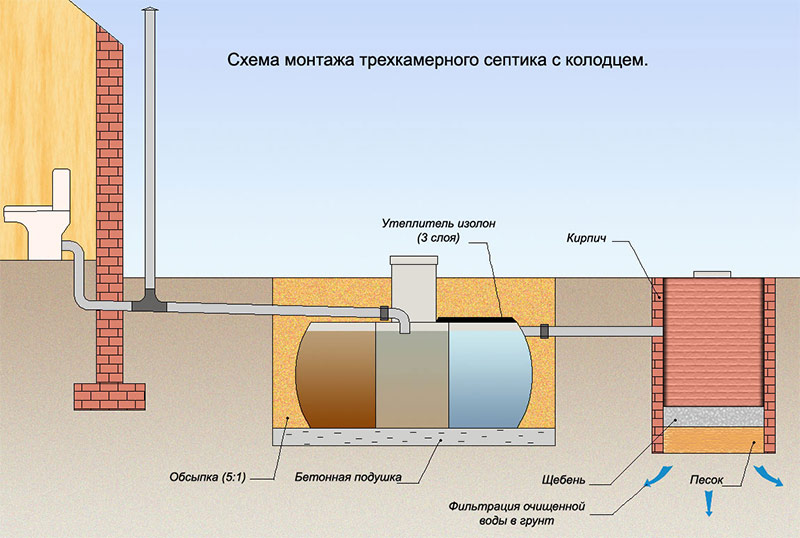
Inside the tank are compartments, passing through which the effluents are cleaned of solid impurities. The filtration well is installed so that its lower edge is above the groundwater level. A two-layer pillow is poured at its bottom, consisting of coarse river or quarry sand, on top of which crushed stone of medium and fine fractions is poured.
One of the options for implementing such waste disposal is a system of overflow wells. Sewage treatment plants of this type can be built of brick or concrete rings without the involvement of specialists. This fact significantly reduces the cost of their creation and operation.
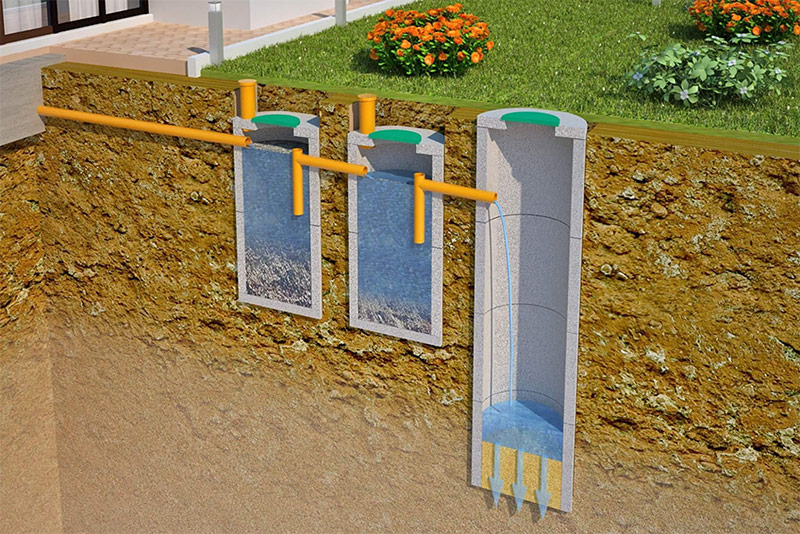
The principle of operation of a septic tank with a filtration well. Wastewater flows through the pipeline to a septic tank with a sealed bottom, solid particles settle to the bottom, and insoluble fats float to the surface.In some cases, there may be several such sedimentation tanks through which sewage flows sequentially.
Partially clarified water is poured into the filtering well through a connecting manifold cut into the wall of the container at a height of 2/3 from the base. At the bottom of this structure there is a pillow of sand and gravel through which moisture seeps. To reduce odors from the sump, it is recommended to periodically use additives containing cultures of anaerobic bacteria. Microorganisms effectively decompose biological waste into relatively safe components.
Gradually, silting of the pillow occurs and replacement of crushed stone and sand with clean ones is required, after which the well will be able to perform its task again. The process of siltation of a well in this case is significantly slowed down, pumping out liquid waste must be done no more than once every six months. The operating time of the structure until the siltation of the bottom of the well is completely dependent largely on the composition of the soil. Sandy and sandy loamy soils absorb water well and, therefore, have a longer resource, clay and loams practically do not absorb liquids, and wells quickly become clogged. Replacing the gravel-sand cushion in the filtration well is done approximately once every five to six years.

+ Pluses of septic tanks with a filtration well
- The main advantages of a septic tank with a well is the simplicity of design.
- Significant time between regular maintenance operations.
- Complete system non-volatility.

- Cons of septic tanks with a filtration well
- It is not possible to place at a high level of groundwater.
- Not suitable for clay soils.
- The level of wastewater treatment is not high.
- It is necessary to regularly clean the septic tank from sludge, but not as often as from cesspools.
- After 5 - 6 years, you will have to change the gravel-sand cushion in the well, the operation is very dirty and time-consuming.
In which case you can use. The performance of such systems is highly dependent on soil composition and groundwater level. Such treatment facilities are used in houses designed for year-round living of a family of three to four people. The system is unable to cope with volley discharge, which can lead to its overflow and leakage of liquid waste to the ground. Uninterrupted operation of such a system is guaranteed if it is used on sandy and sandy loamy soils, as well as chernozem and loam with a predominance of sand, with a low occurrence of groundwater.
Septic tank with a filtration field
The septic tank device with a filtration field. Tighter environmental standards make it necessary to improve autonomous treatment facilities. A multi-stage septic tank with a filtration field is a complex system and it includes such components:
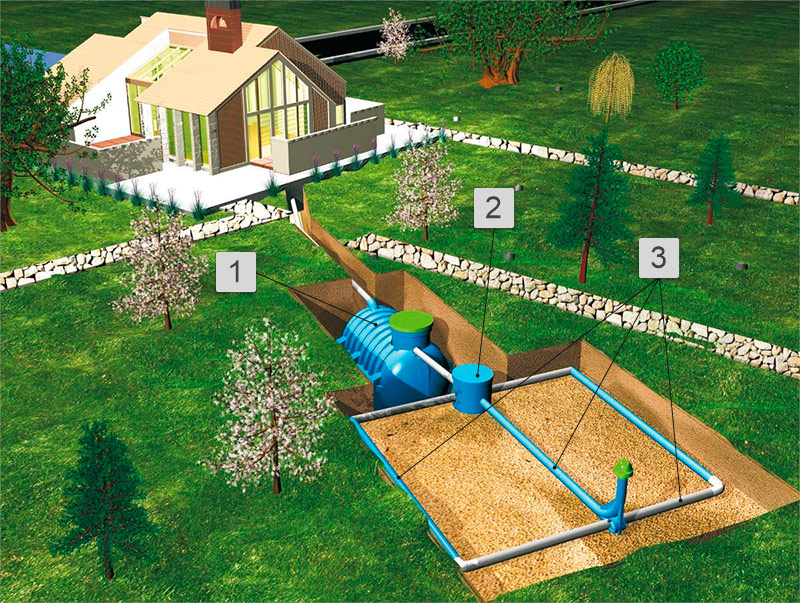
1. Sedimentation tank. 2. Distribution well.3. Underground filtration fields. They consist of perforated pipelines and gravel-sand cushions located in the ground, which act as filters. The thickness of the filter element is from 1 meter or more.
The principle of operation of a septic tank with a filtration field.Effluents from the internal sewage fall into a sump consisting of two or three chambers. In the first compartment, the waste settles, and a gradual subsidence and ascent of insoluble contaminants occurs. The clarified water is poured into the following chambers, where the subsequent stages of purification pass. Further, the water from the sump flows into the distribution well. From the well, water enters the pipes of the filtration field and seeping through the holes in the pipes, it is absorbed in the fields almost completely.
Some systems are equipped with another well, which is installed behind the filtration field, as well as a drainage system. Water enters this well from the drainage system, which is subsequently pumped into the outlet channel using a pump.
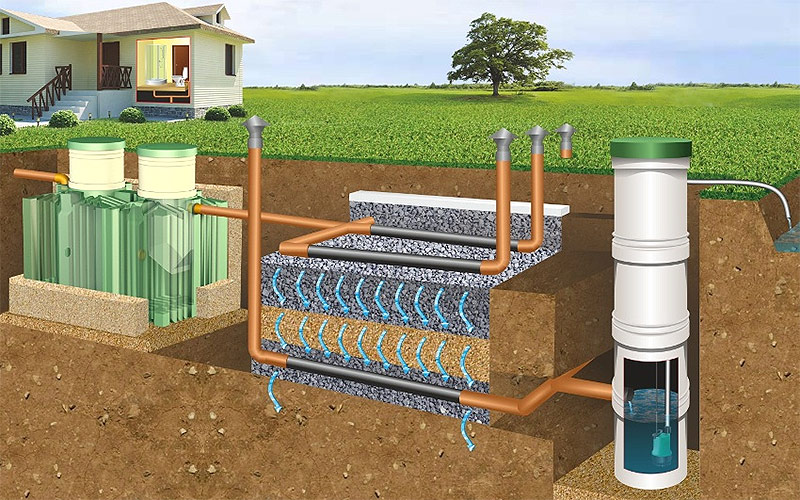
To accommodate such structures, significant areas of over 30 square meters are needed. meters.The performance of underground filtering fields largely depends on the composition of the soil: the best option is sand, the worst is clay. Purified water enters the aquifer or is collected in drainage ditches or wells. The service life of the fields before siltation is approximately 10 years, after which the sand and gravel cushion must be replaced.

+ Pros of a septic tank with a filtration field
- High performance.
- Maintenance-free for a long period.

- Cons septic tank with a filtration field
- Significant areas are required for mounting the filtration field.
- The level of water purification from pollution in such systems is not high enough for its use even for irrigation or household needs.
- The high cost of construction.
- After about 10 years, the filtration system will become silted up and its reconstruction is necessary, which is an expensive and laborious process.
In which case you can use. The use of septic tanks with filtration fields is possible only on land plots of a large area. The high performance of such structures allows their use in homes with a large number of residents. On the platforms under which the filtration fields are located, it is possible to break flower beds and lawns, it is forbidden to plant cultivated plants, trees and shrubs. The accumulation of harmful substances in the fruits of cultivated plants can lead to an outbreak of gastrointestinal diseases.
Septic tank with infiltrator
The infiltrator is a replacement for drainage pipes, and its main advantage is a much smaller area compared to the filtration field. An infiltrator is a long plastic tank that resembles a trough. Only it is installed bottom to top and has an inlet and outlet. A 400 liter infiltrator can replace about 35 meters of filter field pipes.
The device of a septic tank with an infiltrator. There are two types of septic tanks with an infiltrator: with an intermediate well located between the septic tank and the infiltrator and without it.
A septic tank with an infiltrator consists of the following components:
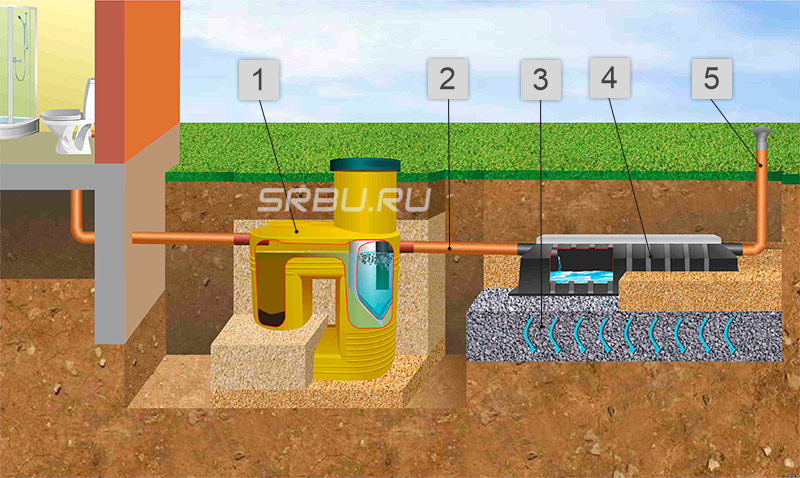
1. Septic tank 2. Trumpet; 3. Cushion of crushed stone; 4. Infiltrator; 5. Ventilation.
A septic tank with an infiltrator and an intermediate well consists of the same elements, but additional devices are added here, which you can see in the infographic below.
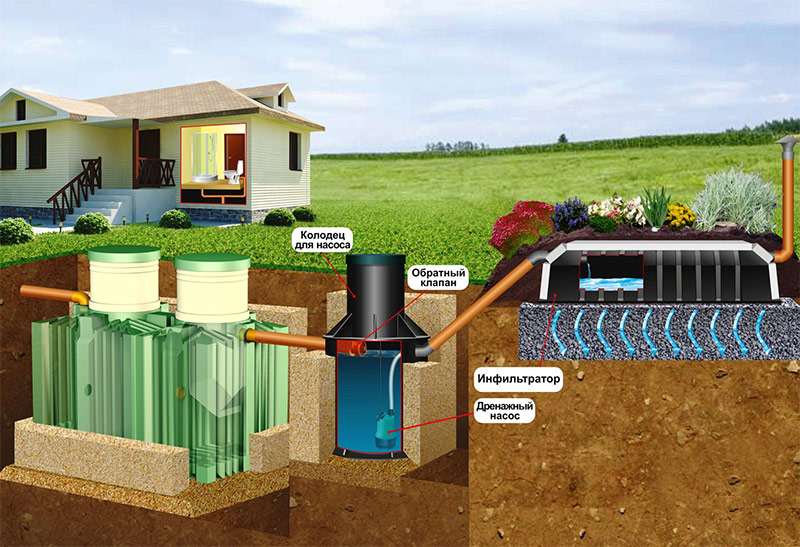
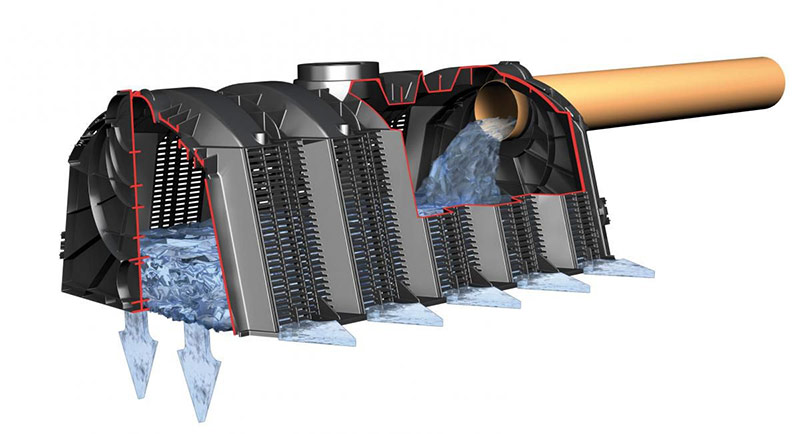
Sectional infiltrator.
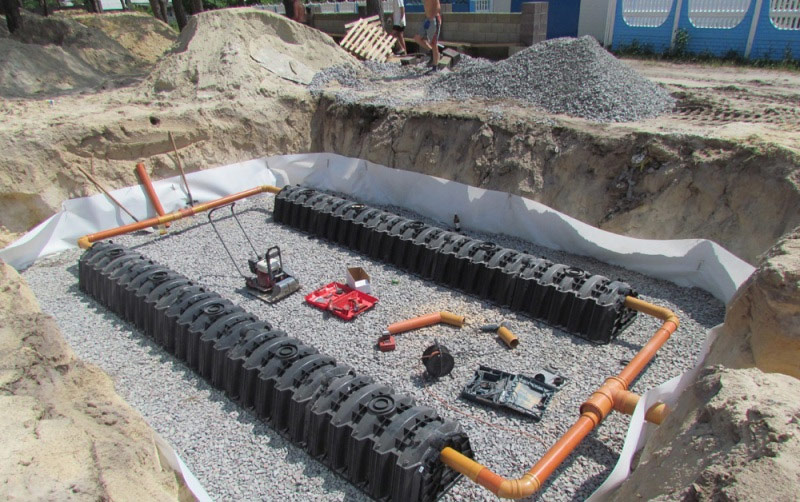
The process of installing infiltrators.
The principle of operation of the septic tank with an infiltrator. First, consider the principle of operation of the infiltrator without a well. Sewer drains enter the septic tank where, passing through several chambers, they undergo a certain treatment. Further, by gravity through the pipeline, they enter the capacity of the infiltrator and are absorbed into the rubble.
The principle of operation of the infiltrator with an intermediate well. The sewage flows through a septic tank and enters the intermediate well, where a drainage pump with a float is located, which draws water into the infiltrator. Further, the drains are absorbed into the pillow of rubble. Such a system is used to prevent sewage from getting back into the septic tank. The system is intended for use in areas with a high level of groundwater and poorly absorbed soils.

+ Pros of a septic tank with an infiltrator
- Does not occupy a large area.
- Simple installation.
- The infiltrator with an intermediate well and a pump can be installed in areas with high groundwater levels.
- Cope with salvo discharge.
- Rare system maintenance.

- Cons of a septic tank with an infiltrator
- Over time, the infiltrator will have to be cleaned, and a pillow of crushed stone replaced, but this will not happen soon.
- A septic tank with an infiltrator and an intermediate well with a pump is volatile.
- The level of water treatment is not high enough.
- The area above the infiltrator can only be used under the lawn.
In which case it is worth using a septic tank with an infiltrator. It is advisable to place this system on well-absorbed soils, such as sand, chernozem, loam with small inclusions of clay and a low level of groundwater.Structures of this type are capable of absorbing a large number of effluents, including volley zbros, when a large amount of water flows simultaneously into a septic tank. It is possible to use in homes with a large number of residents.
In which case it is necessary to use a septic tank with an infiltrator and an intermediate well. It is advisable to use a system with an intermediate well and a pump in areas with a high level of groundwater. The use of an intermediate well with a pump and a non-return valve prevents the effluent from returning to the septic tank if the effluent entering the infiltrator will be absorbed very slowly.
Bio-treatment systems
The high level of groundwater and limited land does not allow the use of traditional methods of water treatment. In such conditions and in order to protect the environment, the use of factory-made biological treatment systems is recommended. There are several varieties of such structures on the market that can provide almost complete purification of water from pollution.
Septic tank with biofilter
The device of septic tanks with a biofilter. Septic tanks with biofilters are used in private households and organizations. In general, the device consists of a septic compartment and a compartment with a biofilter. In the compartment with the biofilter there is a backfill of a certain non-rotting material: expanded clay, foam, synthetic fibers. During the operation of the septic tank, a biofilm consisting of numerous bacterial colonies is formed on the surface of the backfill. Now we will consider what constituent elements various septic tanks with biofilters consist of.
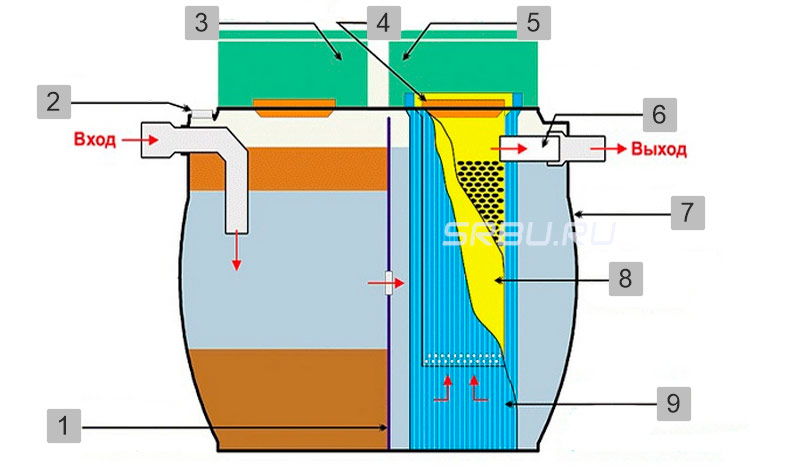
1. The membrane with holes; 2. Ventilation; 3. Ring number 1; 4. A stub; 5. Ring number 2; 6. Biofilter latch; 7. LOU building; 8. Biofilter with loading; 9. Flat filter.
Examples of other septic tanks with a biofilter:
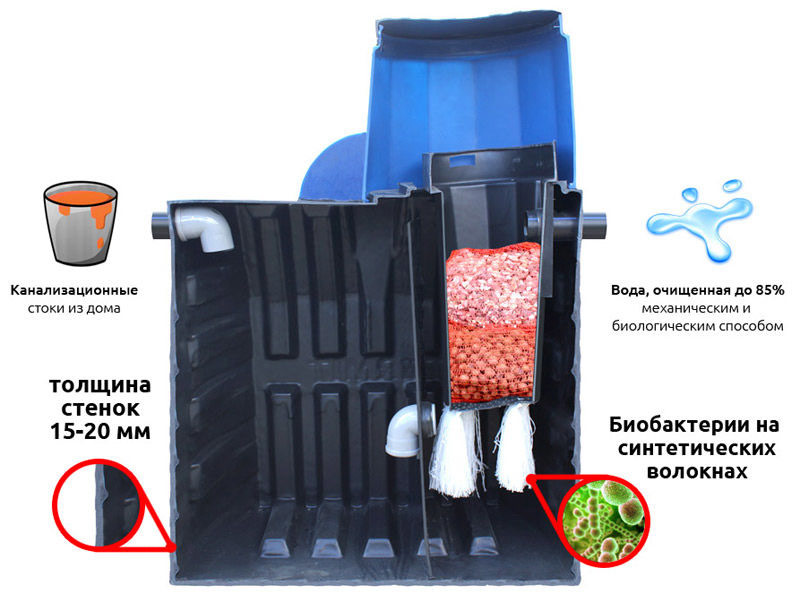
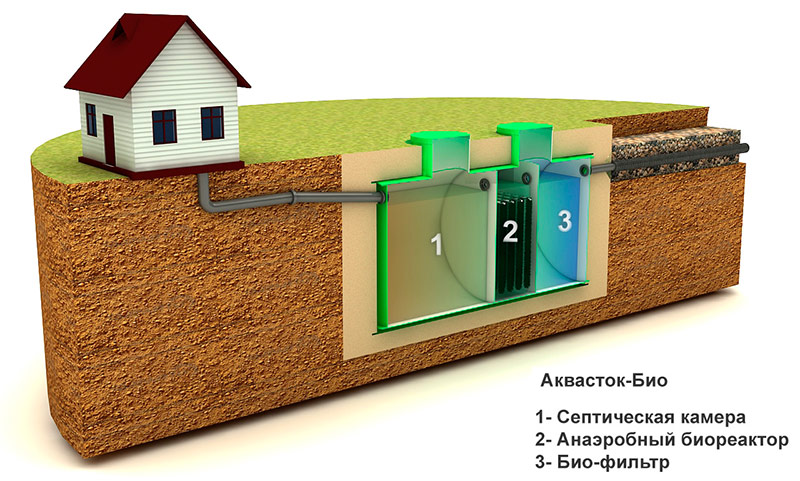
The principle of operation of a septic tank with a biofilter. Drains through the input collector enter the first compartment of the septic tank, which serves as a sump. Here, sedimentation of solid particles and the separation of fats followed by their ascent. The wall between the compartments is a membrane with many calibrated holes through which conditionally clarified water is poured into the second chamber. Here, the liquid passes through a coarse filter where solid particles are removed. For these purposes, special fabric or other materials are used.
The last stage of water purification takes place in a chamber with anaerobic bacteria, which in the process of life destroy organic compounds. After that, the filtrate enters the storage tank and can be used for technical needs. Water may be discharged to the ground or into the drainage ditch, the level of residual pollution is not sufficient to have a significant impact on the environment.

+ Pros of a septic tank with a biofilter
- A good degree of water purification is 85 - 95%.
- They do not require frequent maintenance; it is enough to pour out preparations containing bacteria into the toilet bowl once a month.
- The system does not require electricity.
- It does not emit unpleasant odors.
- Installation is quite simple and does not take much time.

- Cons septic tank with biofilter
- We will not allow a long simple system (2-3 weeks), as a result of which bacterial death can occur.
- Bacteria do not tolerate bleach and many chemical detergents used in everyday life.
- There is a need to add biological products.
- The cost of the system is more expensive than a conventional septic tank.
In which case it is worth choosing a septic tank with a biofilter. Septic tank with bio-purification can be used in individual houses, which are used for permanent residence. Such structures do not require frequent maintenance and are easy to use, so the introduction of microorganism cultures can be carried out through the toilet. The main disadvantage is the possible death of anaerobic bacteria with prolonged simple stand-alone sewage. The cycle from the time of introduction of new cultures to achieve maximum efficiency reaches 14 -15 days.
Forced biological treatment plant
The device system with forced air supply. To determine how to choose an autonomous sewer for a private house with a large number of residents, we consider the possibilities of deep biological treatment plants. Such systems are characterized by high performance, over 1.5 cubic meters. meters of sewage per day. The septic tank equipment with forced air supply is located in one case, divided into several compartments:
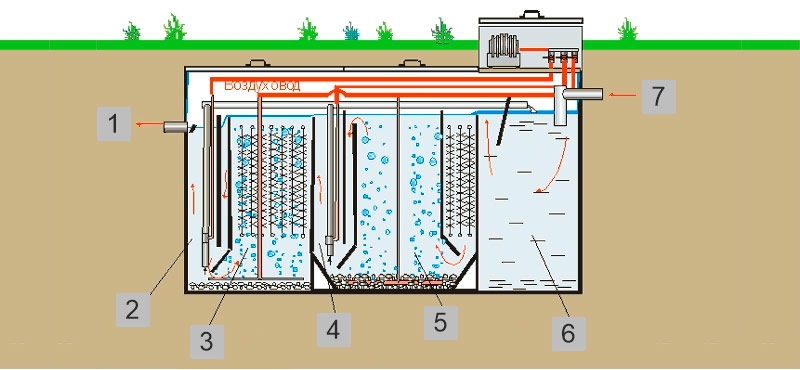
1. Issue; 2. Tertiary sedimentation tank; 3. The first stage aeration tank; 4. Secondary sedimentation tank; 5. Aerotank of the second stage; 6. Sump trap for collecting sludge, sand, fats; 7. Input drains.
An example of the device of another deep bio-treatment station:
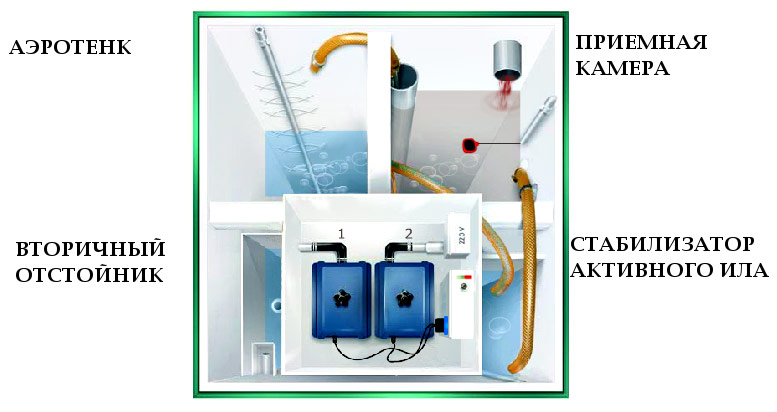
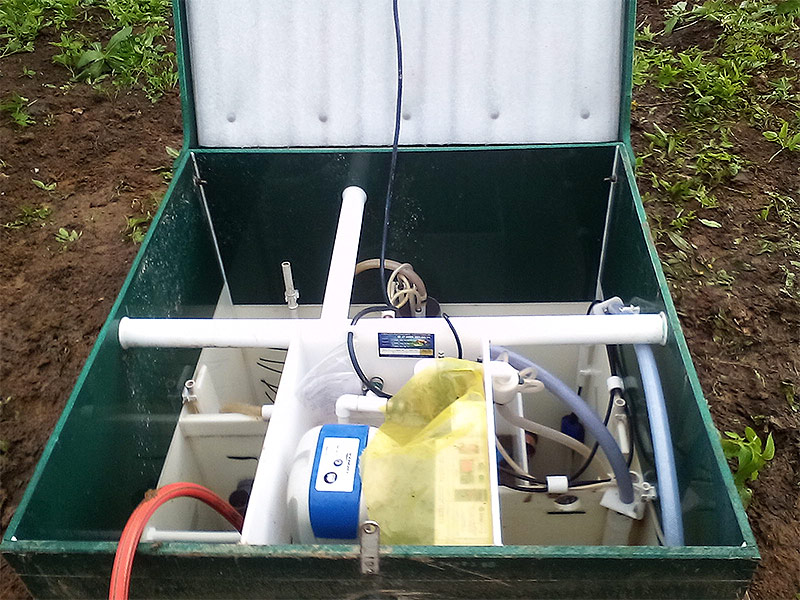
Deep cleaning system with open sunroof.
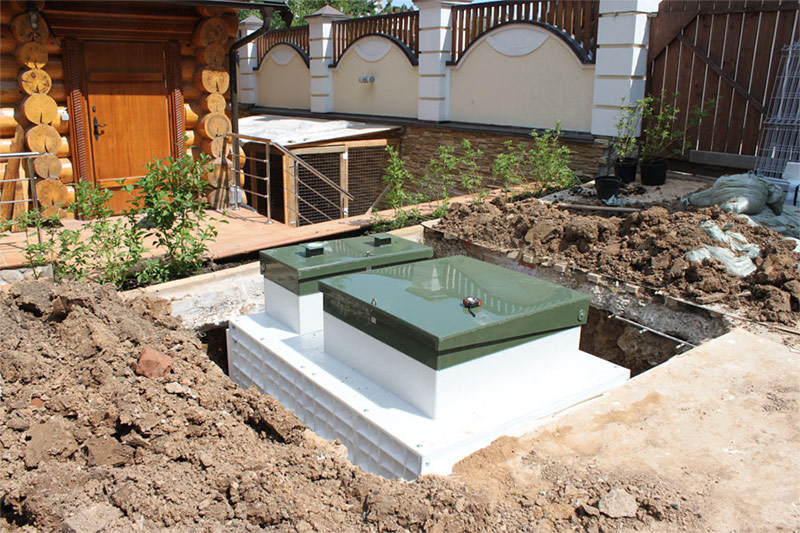
The installation process of a deep wastewater treatment system.
Examples of water drainage from the station:
The principle of operation of the deep bio-treatment station. The effluents enter the sump, in which the process of separation of fat occurs using a special device and the sedimentation of insoluble particles with the formation of sludge. Next, the filtrate is mixed with activated sludge, consisting of algae and microorganisms of the aerobic type. To intensify the processes of their life, the compartment is aerated with outside air, which is pumped by an electric pump. In the last compartment, sludge is deposited, which is subsequently pumped into the aeration tank for reuse and creating a closed cycle. Water purified to a level of 98-99% is drained into a drain or used for household needs.

+ Advantages of the deep bio-treatment station
- Water undergoes a fairly deep purification, which is 98 - 99% and can be used for technical needs.
- Installations are quite compact.
- Do not emit unpleasant odors.
- Installation is quite simple.
- Are established on any sites irrespective of level of soil in and type of soil.
- Consumables in the form of various biological products are not required.
- The system is quite durable and is designed to operate for decades.

- Cons of deep bio-treatment station
- For the functioning of the system, a constant supply of air is required, and therefore a constant supply of electricity to the installation.
- Without air supply, aerobic bacteria begin to die.
- Systems of this type are quite expensive.
- A prolonged absence of effluent leads to the death of bacteria and microorganisms that make up activated sludge.
- Over time, a significant amount of sludge accumulates and must be removed, this procedure is carried out 2 times a year.
In which case it is worth using. The main advantage of a septic tank with forced air supply is high productivity and the degree of water purification. Such equipment has no restrictions on use, it is optimal for houses with a large number of residents and requires virtually no maintenance. It can be installed on any soil, regardless of the level of groundwater.
General criteria for choosing a septic tank for a country house
The issues of autonomous sewage in each case are decided individually, taking into account a number of factors. The main criteria for choosing an autonomous sewage system for a residential building:
1. Purpose of the building: for permanent or temporary residence.
Some types of treatment equipment do not allow long downtime. For cottages and small houses, a cesspool of the accumulative type of the estimated volume is suitable.
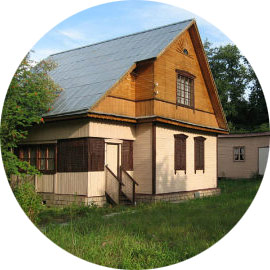
2. Dimensions and geology of the land, as well as soil composition and groundwater level.
On small sites it is impossible to use septic tanks with underground filtering fields. It is not allowed to use septic tanks with a filtration well at a high groundwater level.
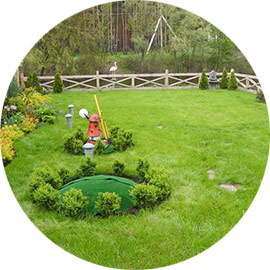
3. The daily volume of runoff and salvo discharge.
It is calculated based on the number of permanent residents in the house and the number of guests who regularly visit the owners. Knowledge of this indicator is necessary to determine the performance of a septic tank, which is indicated in the technical documentation.
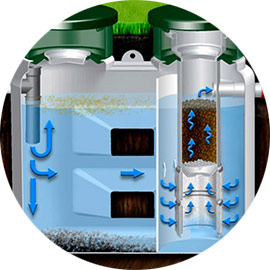
4.Homeowner's financial opportunities.
High-tech equipment, taking into account the costs of installation and maintenance, will be quite expensive. To reduce costs, it is recommended the construction of one- or two-chamber septic tanks from available materials and without the involvement of specialists.

To determine which autonomous sewage system to choose for a private house, one should take into account all of the above factors and, if necessary, consult and involve specialists in the matter. Mistakes made during the design and installation of autonomous sewage systems can cause extremely negative consequences.

